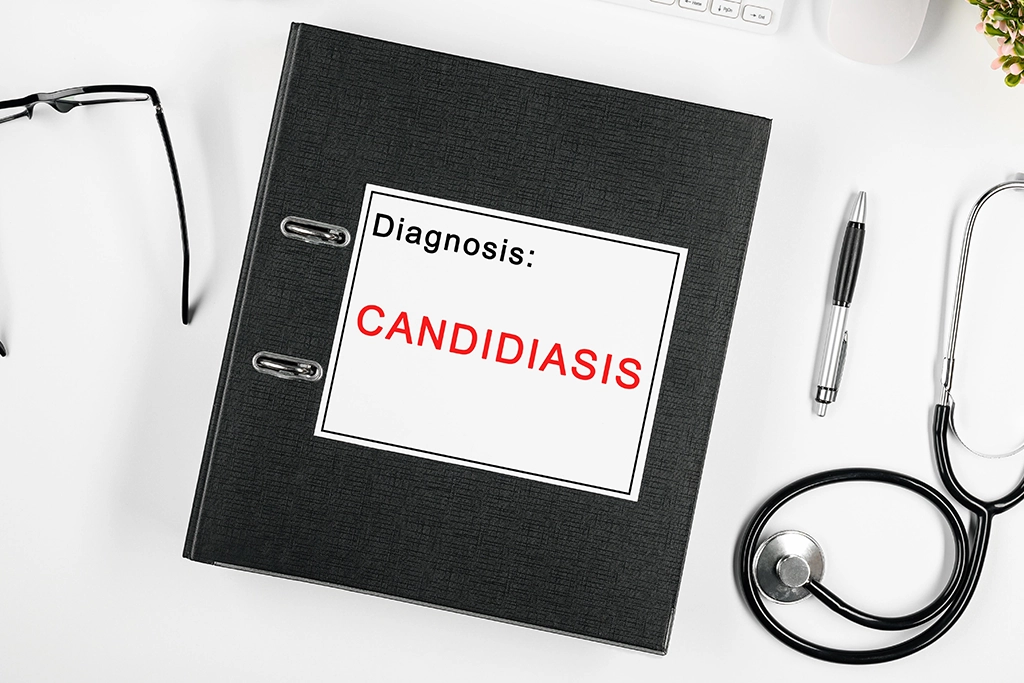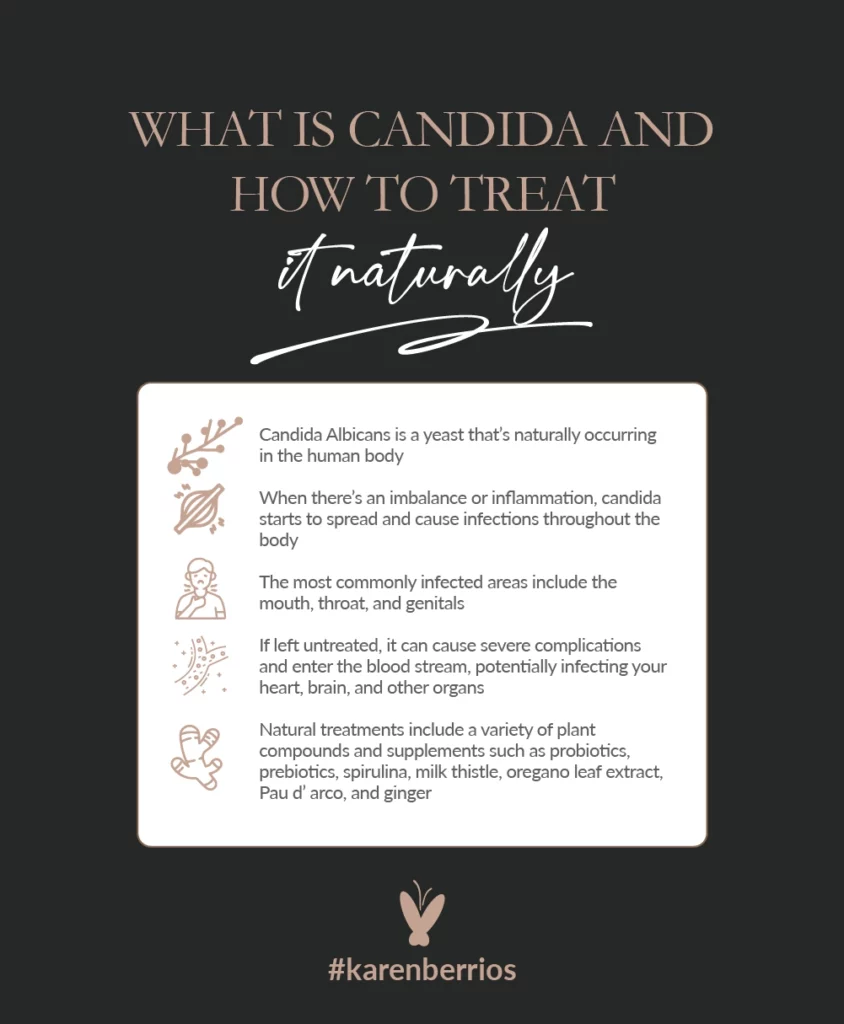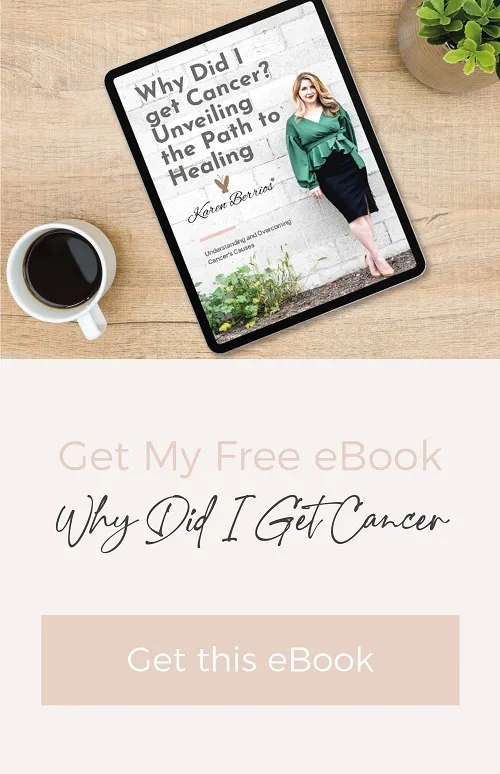

What is Candida and How to Treat it Naturally?
Whenever we feel sick or ill, our mind goes to bacteria, viruses, and potential food-related causes of our symptoms. There are plenty of other causes that can be just as detrimental to our health, from environmental toxins and hormone disruptors to autoimmune diseases and fungi.
Candida is a type of fungus that exists in many forms, and one of its species, Candida Albicans, resides on the human skin and in your gut, throat, mouth, and vagina. When everything is in balance, candida causes no problems and normally thrives in her environment, but when there’s inflammation in the body, it’s known to wreak havoc and cause a fungal infection called candidiasis. The infection can range from mild to severe, depending on where it spreads and in which amounts.
Candidiasis
Candida Albicans causes this fungal infection, also known as yeast infection, and there are several different types that can cause problems in the human body. The most common candida infections include:
Thrush (Oropharyngeal Candidiasis)
This type of fungal infection spreads in the mouth and throat, and it’s usually common in newborns, those taking corticosteroid medications and antibiotics, people diagnosed with diabetes, those wearing dentures, and patients being treated for cancer. The most at-risk group are those with a weakened immune system and the elderly.
The most common symptoms include:
- White and yellow patches on the tongue, as well as your inner cheeks, the roof of your mouth, lips, and gums
- Itchiness, redness, and soreness in the mouth
- Pain with swallowing
- Cracking at the corners of the mouth
Genital Yeast Infection (Genital Candidiasis)
Prevalent in women, genital yeast infection, or vaginal yeast infection occurs when the vaginal flora is out of balance. The usual causes and triggers include pregnancy, antibiotics, birth control pills, diabetes, specific products, wearing the wrong kind of unbreathable underwear, and a weakened immune system. Sometimes it can also be transmitted during sexual intercourse.
The usual symptoms include:
- Redness, itchiness, and swelling inside and outside the genitals
- Pain and burning sensations during urination
- Pain and discomfort during intercourse
- Unpleasant vaginal discharge
The symptoms, especially in women, are similar to a variety of different kinds of infections or sexually transmitted diseases. Hence, it’s important to immediately see your doctor to rule out anything else other than candida infection.
Invasive Candidiasis
The most severe case of candida infection is invasive candidiasis which occurs when the candida enters your bloodstream and travels throughout your body, reaching your heart, bones, brain, eyes, and other organs. It’s extremely dangerous and can cause life-threatening infections.
It usually happens in a hospital setting or a nursing home, but the chances are high if your immune system is critically weakened or you are diagnosed with diabetes. The usual symptoms mainly include fever and chills, which doesn’t make it stand out. That’s why it’s essential to always find out the exact root cause of your symptoms so you can get adequate treatment.
Other Causes of Candida Overgrowth
The factors that contribute to candida overgrowth include:
- Eating a high-processed and high-sugar diet
- Alcohol
- High levels of stress and anxiety
Treatment of Candida Infections
The usual treatment of fungal infections includes some sort of antifungal medication, whether in the form of a pill, cream, suppository, or in the case of invasive fungal infections, an intravenous dose.
Some people are generally prone to fungal infections, whether caused by Candida Albicans or other species, so they might even be advised to take antifungal medication before taking antibiotics, performing surgery, or starting any other medical treatment.
Natural Treatments
Some people don’t want to take the antifungal medication for various reasons, and are also usually more focused on prevention rather than treatment. They prefer to take the natural route; luckily, some powerful plant compounds and dietary supplements can be just as effective in preventing and treating fungal infections.
Some of the most common include:
- Probiotics – a strain of bacteria called Lactobacillus acidophilus acts against candida and prevents her from spreading
- Prebiotics – dietary fiber founds in most vegetables, beans, legumes, and some fruit, helping restore a healthy gut microbiome by feeding the good bacteria and preventing imbalance
- Supplements such as milk thistle, molybdenum, and NAC to cleanse and support your liver
- Oregano leaf extract – a strong antifungal plant extract that’s been proven to be efficient in its fight against Candida Albicans
- Caprylic Acid – another strong antifungal remedy derived from coconut oil
- Spirulina – studies show its incredible power against candida infections, especially in vaginal candidiasis
- Pau d’arco – this potent plant has been used as an antimicrobial and antifungal treatment for hundreds of years, and it’s proving to be efficient in its fight against Candida Albicans as well
- Ginger – another powerful plant that’s been used as a remedy for thousands of years, ginger has potent antimicrobial and antifungal properties
Additionally, someone who is prone to or struggling with a yeast infection should consider changing their lifestyle habits and focusing on their diet. They should abstain from alcohol and processed foods, limit their intake of sugar, and work on reducing stress in their lives. They should also talk to their doctor about potentially switching up their birth control and get tested to make sure there isn’t an underlying condition causing inflammation in their body.
It’s also important to add plenty of anti-inflammatory foods into your diet, helping restore your gut flora and prevent candida from causing more damage.
Foods to Avoid
Some general foods to avoid if you’re fighting a candida infection or you’re prone to it include:
- Highly processed foods
- Foods and drinks high in sugar
- Gluten-containing grains
- Deli meats and farm-raised fish
- Dairy products
- Sugar-containing condiments and dressings
- Artificial sweeteners
- Nuts and seeds that are higher in mold
- Alcohol, caffeine
- Refined oils and fats
This elimination diet is also known as the Candida diet. Its goal is to reduce inflammation, kill off candida by cutting off her food supply, and prevent her from spreading and causing another yeast infection.

Candida Albicans and Cancer
For years now, researchers have been concerned about the connection between Candida Albicans and cancer. The latest research shows that this yeast is indeed promoting cancer through several mechanisms. It seems to be involved in the production of carcinogenic byproducts, acts as a severe trigger for inflammation, engages in molecular mimicry, and induces the Th17 response.
Since chemotherapy and immunotherapy cause a severely weakened immune system, your body can’t fight off new infections efficiently, allowing candida to cause severe infections throughout the body. And in most cases, patients undergoing treatment aren’t allowed antifungal drugs or other harsh medication that might be potentially harmful to their body.
That’s why it’s crucial to take matters into your own hands and focus on the aspect of candida infections you can control: prevention and natural remedies.
Final Thoughts
Candida Albicans is a yeast that might be naturally occurring in the human body, but it can cause a plethora of serious fungal infections, affecting almost every organ. Other candida strains can also cause yeast infections, but they aren’t as easy to spread and wreak havoc.
Focusing on your diet and lifestyle choices is the best way of getting rid of candida and managing her symptoms for good, as even antifungal medication cannot ensure you it won’t be back. Candida and treatment go together only if you put in the work, and when it comes to strengthening your immune system and keeping it functioning at its best, there’s no one who can do a better job than you.

hey there
I'm Karen!
I have found my cancer journey to be a positive and profound transformational experience. I’m inspired to share my healing journey here, and trust you’ll find hope, encouragement and purpose as you discover the healing power that lies within you.
Join
The Mailing List!
By signing up for my newsletter, you agree with our Privacy Policy and Terms & Conditions.


